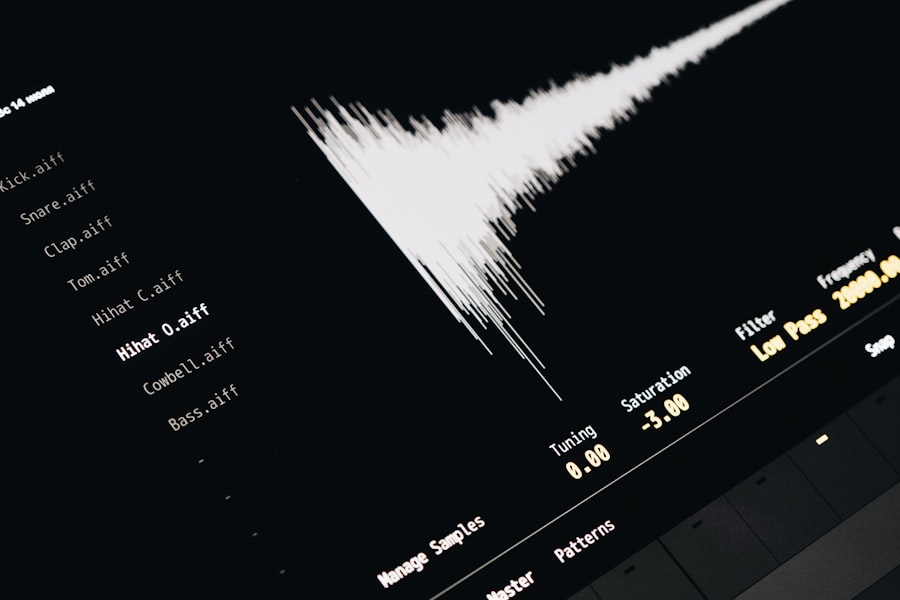Bitrate is a fundamental concept in the realm of digital audio, representing the amount of data processed per unit of time, typically measured in kilobits per second (kbps). It serves as a crucial determinant of audio quality, influencing how sound is encoded and ultimately perceived by listeners. A higher bitrate generally indicates a greater amount of data being used to represent the audio signal, which can lead to improved fidelity and clarity.
For instance, a standard bitrate for high-quality MP3 files is often around 256 kbps or higher, while lower bitrates, such as 128 kbps, may result in noticeable compression artifacts and a loss of detail in the sound. The relationship between bitrate and audio quality is not linear; rather, it is influenced by various factors including the audio format, the complexity of the sound being recorded, and the listening environment. For example, a simple acoustic guitar track may sound acceptable at a lower bitrate compared to a full orchestral piece, which requires more data to accurately capture the nuances of each instrument.
Additionally, the human ear has its limitations; beyond a certain bitrate threshold, the differences in audio quality may become imperceptible to most listeners. This phenomenon underscores the importance of understanding not just what bitrate is, but how it interacts with other elements of audio production and playback.
Key Takeaways
- Bitrate determines the quality of audio files, with higher bitrates generally resulting in better sound quality.
- When choosing the right bitrate for audio files, consider the type of content and the intended use, as well as the storage and bandwidth limitations.
- To maximize audio quality with bitrate settings, use variable bitrate (VBR) encoding and consider the trade-off between file size and sound quality.
- Different audio formats have varying impacts on bitrate, with lossless formats requiring higher bitrates for optimal quality.
- Balancing file size and audio quality with bitrate settings involves finding the right compromise for the specific use case and audience preferences.
Choosing the Right Bitrate for Your Audio Files
Selecting the appropriate bitrate for audio files involves a careful consideration of several factors, including the intended use of the audio, the target audience, and the playback environment. For instance, if you are producing music for streaming platforms, you might opt for a bitrate that balances quality with efficient data usage. Streaming services often recommend bitrates ranging from 128 kbps to 320 kbps for optimal performance without excessive buffering or data consumption.
In contrast, if you are creating audio for professional purposes, such as mastering an album or producing high-fidelity recordings for audiophiles, you may choose lossless formats like FLAC or WAV that support higher bitrates and preserve more detail. Another critical aspect to consider is the type of content being produced. For spoken word recordings, such as podcasts or audiobooks, lower bitrates can suffice since the frequency range is narrower compared to music.
A bitrate of 64 kbps to 128 kbps may be adequate for clear speech without unnecessary file size inflation. Conversely, for music that features a wide dynamic range and intricate soundscapes, higher bitrates are essential to capture the full spectrum of sound. Ultimately, the choice of bitrate should align with both the technical requirements of the audio format and the listening preferences of your audience.
Tips for Maximizing Audio Quality with Bitrate Settings

To maximize audio quality while managing bitrate settings effectively, it is essential to employ a few strategic practices during the recording and encoding processes. First and foremost, starting with high-quality source material is crucial. Recording at a high sample rate and bit depth can significantly enhance the final output.
For example, capturing audio at 24-bit/96 kHz provides a broader dynamic range and greater detail than standard CD-quality recordings (16-bit/44.1 kHz). This high-quality source allows for more flexibility when adjusting bitrate settings during encoding without sacrificing audio integrity. Another important tip is to choose the right encoding format based on your needs.
Lossy formats like MP3 or AAC are suitable for casual listening and streaming due to their smaller file sizes, but they do introduce compression artifacts that can degrade quality at lower bitrates. On the other hand, lossless formats like FLAC or ALAC maintain original audio fidelity but result in larger file sizes. When encoding audio files, consider using variable bitrate (VBR) encoding instead of constant bitrate (CBR).
VBR adjusts the bitrate dynamically based on the complexity of the audio signal, allowing for better quality at lower average bitrates by allocating more data to complex sections while reducing it in simpler parts.
The Impact of Bitrate on Different Audio Formats
| Audio Format | Bitrate (kbps) | File Size per Minute (MB) | Quality |
|---|---|---|---|
| MP3 | 128 | 0.96 | Good |
| MP3 | 320 | 2.40 | Excellent |
| WAV | 1411 | 10.61 | Lossless |
| FLAC | 1000 | 7.50 | Very Good |
Different audio formats exhibit varying behaviors concerning bitrate and audio quality. For instance, MP3 is one of the most widely used lossy formats due to its balance between file size and sound quality. However, it is essential to recognize that not all MP3 encoders are created equal; some may produce better results than others at the same bitrate due to differences in compression algorithms.
Similarly, AAC (Advanced Audio Codec) is often regarded as superior to MP3 at equivalent bitrates because it employs more advanced psychoacoustic models that better preserve audio quality. In contrast, lossless formats like WAV and FLAC do not compromise on quality regardless of bitrate since they retain all original audio data. WAV files are uncompressed and typically larger in size but are favored in professional settings where audio fidelity is paramount.
FLAC offers a compromise by compressing audio without losing any information, making it an excellent choice for audiophiles who want high-quality sound without excessive storage requirements. Understanding these distinctions is vital when selecting an audio format based on your specific needs and desired outcomes.
Balancing File Size and Audio Quality with Bitrate Settings
Finding an optimal balance between file size and audio quality is one of the most significant challenges faced by audio producers and consumers alike. High bitrates yield superior sound quality but result in larger file sizes that can be cumbersome for storage and sharing. Conversely, lower bitrates reduce file sizes but can compromise audio fidelity.
This trade-off necessitates careful consideration of how audio will be used and consumed. For example, if you are distributing music through digital platforms where bandwidth may be limited or where users expect quick downloads, selecting a moderate bitrate that maintains acceptable quality while minimizing file size becomes essential. One effective strategy for achieving this balance is to conduct listening tests at various bitrates before finalizing your settings.
By comparing how different bitrates affect your specific audio content, you can identify a threshold where quality remains satisfactory without inflating file sizes unnecessarily. Additionally, consider your audience’s preferences; if they are primarily casual listeners using standard headphones or mobile devices, they may not notice subtle differences in quality at lower bitrates compared to audiophiles who demand pristine sound reproduction.
How to Adjust Bitrate Settings for Streaming and Downloading

When adjusting bitrate settings for streaming versus downloading, it is crucial to recognize that each scenario has distinct requirements influenced by user experience and technical constraints. For streaming applications, where real-time playback is essential, adaptive bitrate streaming techniques can enhance user experience by adjusting the quality based on available bandwidth.
For downloadable content, however, users often prefer higher-quality files since they can store them locally without concerns about immediate bandwidth limitations. In this case, offering multiple bitrate options can cater to diverse user needs; providing choices such as low (64 kbps), medium (128 kbps), and high (320 kbps) allows users to select based on their storage capacity and listening preferences. Additionally, consider implementing clear labeling for each option so users understand what they are choosing regarding quality versus file size.
Common Mistakes to Avoid When Setting Bitrates for Audio
Several common pitfalls can undermine efforts to optimize bitrate settings for audio files. One frequent mistake is failing to consider the playback environment when selecting bitrates. For instance, if your audience primarily listens through high-quality headphones or professional studio monitors, opting for lower bitrates may lead to disappointing results due to audible compression artifacts.
Conversely, if your target audience primarily uses mobile devices or standard earbuds in noisy environments, higher bitrates may be unnecessary. Another common error involves neglecting to perform thorough listening tests across different devices before finalizing bitrate settings. Relying solely on visual representations of waveforms or spectrograms can be misleading; subjective listening experiences often reveal nuances that technical analysis cannot capture.
By testing your audio on various playback systems—ranging from high-end speakers to budget earbuds—you can gain valuable insights into how your chosen bitrate impacts overall sound quality across different contexts.
The Future of Audio Quality and Bitrate Settings
As technology continues to evolve, so too does the landscape of audio quality and bitrate settings. Emerging technologies such as high-resolution audio formats and advanced compression algorithms promise to enhance listening experiences while addressing challenges related to file size and bandwidth limitations. For instance, formats like MQA (Master Quality Authenticated) aim to deliver studio-quality sound in smaller file sizes by utilizing sophisticated encoding techniques that preserve more detail than traditional lossy formats.
Moreover, advancements in machine learning and artificial intelligence are beginning to influence how we approach audio encoding and compression. These technologies can analyze audio content more intelligently than traditional methods, allowing for smarter bitrate allocation based on content complexity and listener preferences. As streaming services continue to dominate the market, we can expect ongoing innovations aimed at improving both accessibility and quality in digital audio distribution.
In conclusion, understanding bitrate’s role in shaping audio quality is essential for anyone involved in producing or consuming digital sound. By carefully considering factors such as intended use, audience preferences, and playback environments while avoiding common pitfalls in setting bitrates, one can achieve an optimal balance between sound fidelity and practical file management.
If you are interested in learning more about the technical aspects of bitrate, you may want to check out this article on professional ethics. Understanding the principles and importance of professional ethics can help guide decisions related to bitrate and other technical considerations in various industries.





















+ There are no comments
Add yours